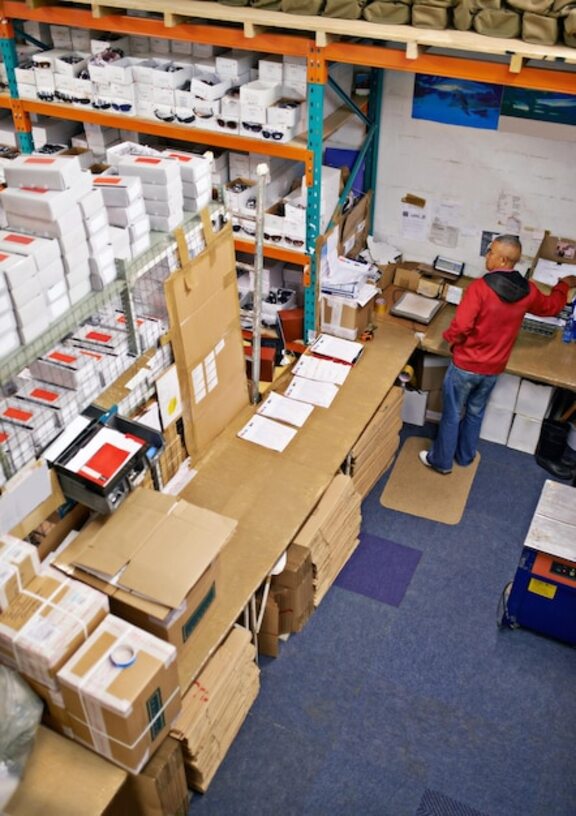Discover how to create an efficient inventory for your move.

Are you about to move and don't know where to start? Making an efficient inventory is the key to ensuring your move is an organized and stress-free process. In this article, we will teach you how to create a detailed list that will help you keep track of your belongings, facilitate organization, and avoid unpleasant surprises along the way. Get ready to discover how to simplify your move with a well-structured inventory!
The importance of an inventory in your move
The importance of an inventory in your move is fundamental to ensure that the process is carried out smoothly and efficiently. A well-prepared inventory not only allows you to keep track of all your belongings but also helps you identify essential items and those that can be discarded or donated. By having a detailed list, you can better plan the distribution of your items in your new home, thus avoiding clutter and facilitating organization from day one. This translates to less stress and more time to enjoy your new space.
Additionally, having an inventory during the move protects you against potential losses or damages. By documenting each item, you can ensure that everything leaving your old home arrives at its final destination. In case of any issues – such as losses or damages – you will have clear evidence of what you owned and its original condition. This way, managing claims with moving companies or insurance becomes much simpler. In summary, an inventory is not only an organizational tool; it is a guarantee to maintain peace of mind during one of the most chaotic moments: moving to a new place.
2. Useful tools for creating your inventory
To create an effective inventory, it is essential to have tools that help you organize your belongings efficiently. A very useful option is to use mobile applications specifically designed for managing moves. These applications typically allow you to add photos, descriptions, and categories to each item, making it easier to organize and access information at any time. Additionally, some of them offer features to share your inventory with family or friends who can assist you during the process. Another valuable tool is a simple spreadsheet, either in Google Sheets or Excel. You can create columns to categorize your belongings by room, condition, and priority. This will allow you to keep a detailed track of what you have and what you need to pack first. Spreadsheets are especially useful if you prefer to work from a computer and can be easily edited or updated as you progress with your move. Do not underestimate the power of good paper and pencil; sometimes, writing manually can help you better remember the items as you pack them.
Finally, consider using adhesive labels or QR codes to mark the boxes as you fill them. By labeling each box with its contents and the room it belongs to, you will be able to quickly locate your belongings when you arrive at your new home. QR codes can link directly to your digital inventory, making the unpacking and organizing process in your new space even easier. With these tools in hand, you will be ready to tackle your move with confidence and organization.
3. How to effectively categorize your belongings
To effectively categorize your belongings, start by dividing your items into groups that make sense for you and your lifestyle. A practical way to do this is by rooms: kitchen, living room, bedroom, bathroom, and workspace. Within each category, you can create subcategories that include similar items, such as kitchen utensils, clothing, or books. This approach will not only give you clearer control over what you own but will also make the packing and unpacking process in your new home easier. Remember to be specific when naming the categories; this will make finding certain items much simpler when you arrive at your new place.
Another important aspect when categorizing your belongings is to keep a visual record. You can take photos of the most valuable or fragile items before packing them and add those images to your inventory. This will not only help you remember exactly what you have and its condition, but it can also be useful for insurance claims in case of damage during the move. Additionally, consider using labels to mark each box with its contents and the corresponding room where they should go in your new home. This small but effective strategy can save time and effort as you adjust to your new space.
4. Strategies for documenting valuable articles
To document valuable items in your inventory, it is essential to adopt a systematic approach that allows you not only to list your belongings but also to highlight those objects of greater importance. An effective strategy is to create categories within your list, such as furniture, appliances, and personal items. This not only facilitates the visualization of what you own but also helps you quickly identify the items that require more attention during the move. When categorizing your items, be sure to include relevant details such as condition, purchase dates, and estimated value; this information will be invaluable for both the moving process and potential insurance claims.
Another useful technique is to take photographs of the most valuable or fragile items before packing. These images will serve as proof of their condition and can be crucial if anything gets damaged during transport. Additionally, by combining the photos with your written inventory, you create a visual record that can make organizing in your new home easier. Consider using mobile apps or specific inventory software; these tools can simplify the process by allowing you to scan barcodes or add notes and photos directly from your device. With clear and accessible documentation, you will ensure a much smoother and more organized move.
5. Tips for conducting a visual inventory with photos
To carry out an effective visual inventory, photography becomes an invaluable tool. Start by capturing images of each room and its contents, making sure to include not only large furniture but also smaller items that could be overlooked. Use your smartphone or a digital camera to obtain clear and well-lit photos. By doing so, you will be able to easily visualize what you have and how it is distributed in your home, which will help you make decisions about what to take with you and what could be donated or sold before the move.
In addition to general photos of each space, consider taking more detailed shots of valuable or fragile items. Include labels in your images if necessary, identifying special elements with notes about their condition or any particular care they require. This practice will not only make the packing process easier by reminding you how the items were arranged but will also serve as a visual record in case you need to file a claim with the moving company for potential damages during the move. With a well-organized visual inventory, you will be one step closer to achieving a smooth relocation.
6. The best way to label boxes during a move
Labeling boxes effectively is one of the most important steps for a successful inventory during a move. Use a color-coding system to sort your belongings by rooms; for example, choose a blue label for the kitchen, green for the living room, and red for the bedrooms. This will not only help you quickly identify which box belongs to each space when you arrive at your new home, but it will also make the unpacking process easier, as you can focus on one room at a time. Additionally, make sure to write a brief description on each label of what is inside, such as "dishes" or "bedding," allowing you to locate specific items without having to open all the boxes.
Another useful technique is to include a number on each box that corresponds to a master list. When creating this list, write down the box number along with its detailed contents. For example, if box number 1 contains "books," "games," and "decorations," you will have a clear and accessible record of the contents. This will not only save you time when looking for essential items after the move, but it will also give you peace of mind knowing that nothing has been lost during the transfer. A good practice is to place this list in a visible location or keep it on your phone for quick access when needed.
7. How to handle fragile items in your inventory
Handling fragile items in your inventory is essential to ensure they arrive at their destination in perfect condition. Start by identifying all delicate objects, such as crystals, ceramics, and appliances, and list them. Once you have this list of items, make sure to have the appropriate materials for packaging: sturdy boxes, bubble wrap, and tape are your best allies. When packing each fragile item, carefully wrap it in bubble wrap and place it in the box, ensuring to fill any empty spaces with cushioning material to prevent movement during transport.
In addition to good packaging, it is essential to clearly label boxes containing fragile items. Use a visible label that indicates "Fragile" and consider adding a note about the specific contents of the box. This will not only inform those helping you move the boxes, but it will also facilitate the unpacking process upon arriving at your new home. Finally, when loading the moving vehicle or organizing inside the truck, always place the more fragile boxes on top or in a location where they will not be crushed by other objects; this will help minimize the risk of damage during transit. With these simple yet effective steps, you can handle your fragile items with confidence and peace of mind.
8. Don't forget to include large furniture: how to do it?
Including large furniture in your inventory is essential to ensure that your move goes smoothly. Start by measuring each piece of furniture, noting their dimensions and special features, such as whether they are disassemblable or not. This information will help you not only to plan the space in your new home but also to determine how to transport them safely. Make sure to record the current condition of each item to assess any damage that may occur during the move.
Also, consider the logistics of moving these heavy furniture items. If necessary, schedule professional services for their packing and transportation; this will prevent injuries and damage to both the objects and the walls of your home. Take the time to think about their arrangement in the new space and note it as part of your inventory; this way you can better visualize how they will fit into your new life. Remember that a good plan always includes those large elements that can complicate things if not managed properly from the start.
9. Periodic reviews: ensuring that nothing is lost
Periodic reviews are a fundamental part of ensuring that your inventory remains updated and complete. As you pack your belongings, it's easy to lose track of some items or even forget what you have already included in your list. Therefore, establishing a review schedule will allow you to keep a constant track of your moving progress. You can schedule weekly or bi-weekly inspections where you check the status of your packed belongings and what still needs to be packed, thus ensuring that nothing gets left behind or lost during the process. Additionally, these reviews help you identify which items you might need to donate, sell, or recycle before the move. By periodically reviewing your inventory, you can make informed decisions about what you really need to take with you to your new home. This will not only make the move easier by reducing the total load but will also contribute to creating a more organized environment in your new space. In summary, conducting regular reviews provides you with peace of mind and assurance knowing that each item is accounted for and ready for transport.
10. Keeping your inventory updated after the move
Keeping your inventory updated after the move is a crucial step that is often overlooked. Once you arrive at your new home, it's easy to lose track of what you have and where everything is. To avoid confusion in the future, make sure to review your inventory list and make the necessary updates. This may include adding new items acquired or removing those you no longer wish to keep. This way, you will always have a clear and accurate view of your belongings, allowing you to better manage the space in your new home.
Additionally, keeping an updated inventory will not only help you maintain a more effective control of your belongings, but it will also facilitate any claims in case of loss or damage. If you ever need to file a claim with an insurance company or simply want to know if you have left any items behind, having a well-documented inventory will be invaluable. Consider using mobile apps or digital tools to record your items; these options are convenient and allow for quick and easy updates. Remember that a good inventory is an investment in long-term peace of mind.



